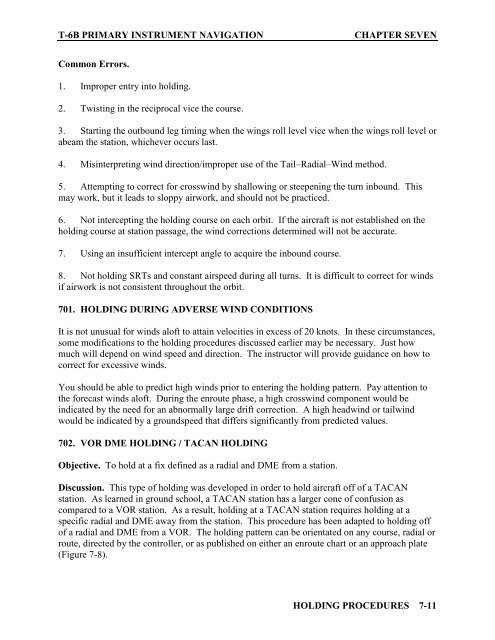Flight Training Instruction - Cnatra - U.S. Navy
Flight Training Instruction - Cnatra - U.S. Navy
Flight Training Instruction - Cnatra - U.S. Navy
You also want an ePaper? Increase the reach of your titles
YUMPU automatically turns print PDFs into web optimized ePapers that Google loves.
T-6B PRIMARY INSTRUMENT NAVIGATION CHAPTER SEVEN<br />
Common Errors.<br />
1. Improper entry into holding.<br />
2. Twisting in the reciprocal vice the course.<br />
3. Starting the outbound leg timing when the wings roll level vice when the wings roll level or<br />
abeam the station, whichever occurs last.<br />
4. Misinterpreting wind direction/improper use of the Tail–Radial–Wind method.<br />
5. Attempting to correct for crosswind by shallowing or steepening the turn inbound. This<br />
may work, but it leads to sloppy airwork, and should not be practiced.<br />
6. Not intercepting the holding course on each orbit. If the aircraft is not established on the<br />
holding course at station passage, the wind corrections determined will not be accurate.<br />
7. Using an insufficient intercept angle to acquire the inbound course.<br />
8. Not holding SRTs and constant airspeed during all turns. It is difficult to correct for winds<br />
if airwork is not consistent throughout the orbit.<br />
701. HOLDING DURING ADVERSE WIND CONDITIONS<br />
It is not unusual for winds aloft to attain velocities in excess of 20 knots. In these circumstances,<br />
some modifications to the holding procedures discussed earlier may be necessary. Just how<br />
much will depend on wind speed and direction. The instructor will provide guidance on how to<br />
correct for excessive winds.<br />
You should be able to predict high winds prior to entering the holding pattern. Pay attention to<br />
the forecast winds aloft. During the enroute phase, a high crosswind component would be<br />
indicated by the need for an abnormally large drift correction. A high headwind or tailwind<br />
would be indicated by a groundspeed that differs significantly from predicted values.<br />
702. VOR DME HOLDING / TACAN HOLDING<br />
Objective. To hold at a fix defined as a radial and DME from a station.<br />
Discussion. This type of holding was developed in order to hold aircraft off of a TACAN<br />
station. As learned in ground school, a TACAN station has a larger cone of confusion as<br />
compared to a VOR station. As a result, holding at a TACAN station requires holding at a<br />
specific radial and DME away from the station. This procedure has been adapted to holding off<br />
of a radial and DME from a VOR. The holding pattern can be orientated on any course, radial or<br />
route, directed by the controller, or as published on either an enroute chart or an approach plate<br />
(Figure 7-8).<br />
HOLDING PROCEDURES 7-11
















